What happened at Fukushima, Japan?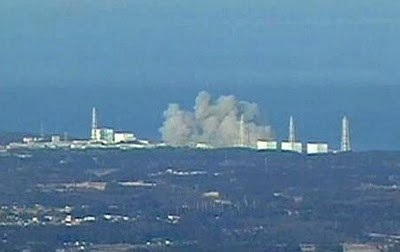
The most powerful earthquake ever recorded in Japan, registering 9 on the Richter scale with an epicenter 100 kilometres offshore from Honshu, Japan’s main island, struck on March 11, 2011. Fukushima Daiichi units 1, 2 and 3 were operating at the time, while units 4, 5 and 6 had been shut down for several months to allow refueling and planned maintenance.
The earthquake triggered automatic reactor shutdowns at the 3 operating units at Fukushima, as it did at the 3 other nuclear stations along that coast; Tokai, Fukushima Daini and Onagawa. Although the earthquake decimated the electrical transmission system throughout the northern half of Honshu, all four stations were safely shut down using their diesel generators and battery backups to keep power flowing and remove the heat of radioactive decay from inside the reactor cores.
However, the earthquake also caused a massive tsunami which was over 40 feet high when it struck Fukushima about 40 minutes later. The photo below shows the break-wall, which was designed to stop what was considered to be a worst-case tsunami of about 18 feet, as it was broken up by the wall of water.
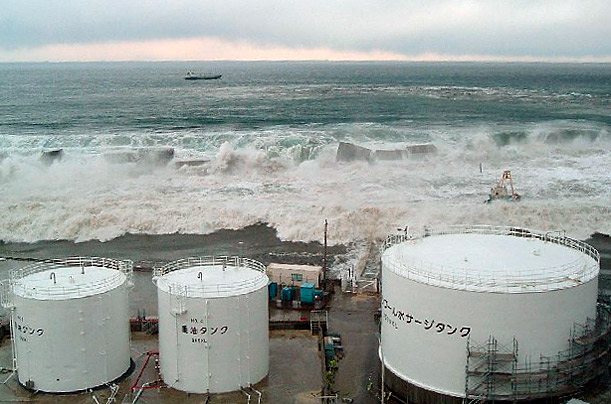
The water surged up the 25-30 feet high shoreline, flooding all six units. Units 1 through 4 were swamped with seawater to a depth of about 15 feet.
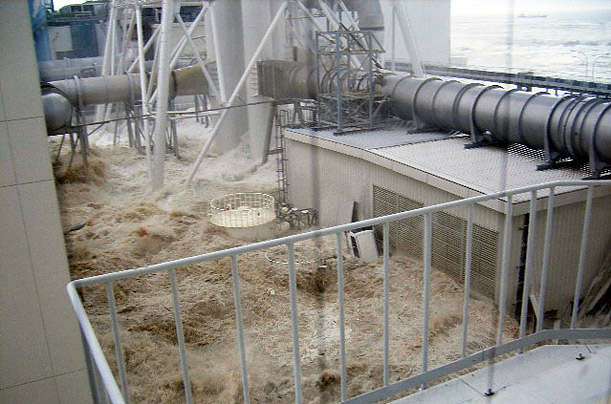
As all of the emergency diesels and DC batteries were located in the power station basements, all of the emergency power systems were flooded and rendered inoperable. Units 5 and 6, located a small distance away and on higher ground, were not significantly impacted by the flood waters.

Unit 1’s reactor core gradually became uncovered over the next 12 hours. The excess heat caused severe fuel damage and the generation of hydrogen. Within another 12 hours, the hydrogen had risen to the top floor of the building, became concentrated and eventually exploded.
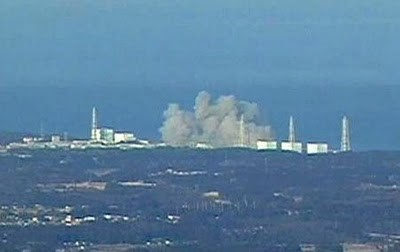
Units 2 and 3 were newer than unit 1 and had a few more steam-powered emergency cooling systems available. Unit 2 depressurization continued for some days and suffered no explosion, although its fuel core was uncovered for extended periods.
Unit 3 depressurization was beset by problems, including damage caused by the unit 1 hydrogen explosion, and was still in progress when it also experienced a hydrogen explosion at 11am on March 14th.
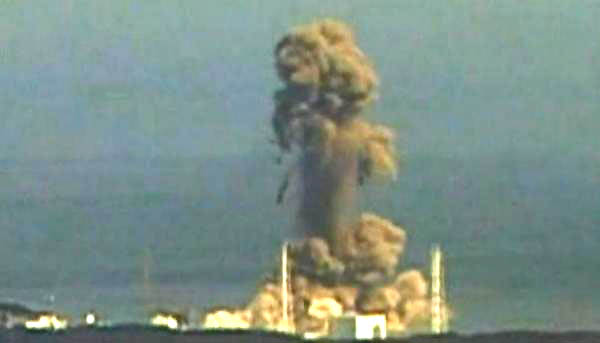
Unit 4 had been shut down for several months and there was no fuel in the reactor. However, hydrogen from unit 3 flowed through the shared air conditioning system, into unit 4 and up to the 5th floor refueling deck where it concentrated. It is believed that a spark in the 4th floor air conditioning circuitry initiated a 3rd and final hydrogen explosion at about 6am on March 15th.
A kilometer-long emergency cable was connected on March 17th. This allowed the operation of installed emergency cooling systems for all three damaged fuel cores and essentially marked the technical end of the Fukushima Daiichi nuclear accident.
Reactor damage: The fuel cores for units 1, 2 and 3 were severely damaged. All three suffered meltdowns, with unit 1 having a full, core-relocating excursion. It is not yet known whether the melted fuel is still in the reactor pressure vessel or whether it has accumulated on the many-feet-thick, steel-reinforced concrete base mat below.
Unit 2 probably had the least amount of melting, and melt-through of the reactor pressure vessel is generally considered unlikely.
Unit 3 had a more likely chance of significant core relocation. Some of the fuel may have penetrated the bottom head of the reactor pressure vessel, but not to the degree of the worst-case speculations for unit 1.
The used fuel bundles stored in the Spent Fuel Pools for units 1 through 4 remained covered with cooling water and, although the cooling water temperature rose temporarily, the water never boiled.
Public impact: A mandatory evacuation of an exclusion zone was applied to a 20 kilometre radius around Fukushima. It included a “deliberate evacuation area”, a connected corridor about 20 kilometres wide that extended to roughly 40 kilometres northwest of the station. The entire evacuated area was popularly dubbed the “no-go zone”.
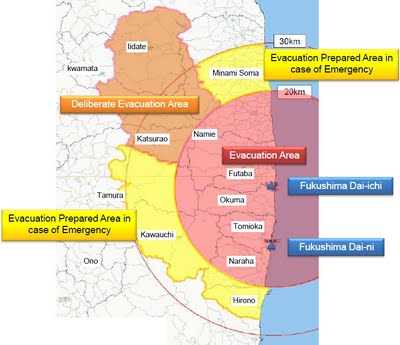
 The order forced some 75,000 people from their homes. Another ~85,000 voluntarily evacuated from outside the mandated exclusion area, fearing both radiation exposure and anxiety caused by belief that the accident could get worse.
The order forced some 75,000 people from their homes. Another ~85,000 voluntarily evacuated from outside the mandated exclusion area, fearing both radiation exposure and anxiety caused by belief that the accident could get worse.
Foods from Fukushima farms were banned from the Japanese marketplace until a monitoring program was put in place to ensure safety. Certain seafood species exceeded Japan’s highly-restrictive limits for marketing and were banned. Milk and dairy products from Fukushima were confiscated to prevent possible ingestion of radioactive iodine.
Fukushima produce and seafood were given detailed monitoring, and none exceeding the national standards ever made it to consumers. As time passed, nearly all foods were found to be less radioactive than national standards and were available for marketing. The only exception has been a few species of food-fish. However, fear of the possibility of radiation, combined with distrust of the government, caused an on-going boycott of all foods associated with Fukushima Prefecture. Four years after the accident, nearly 20% of the consumer demographic continued to shun all foods from Fukushima, even though contamination was undetectable.
Impact on Energy: All nuclear plants were ordered to shut down at their first refueling outage following the accident until stricter safety standards could be created and implemented. The last nuclear station to go off-line was in May 2012, effectively stripping Japan of nearly 30% of its electricity generating capacity. The forced restart of moth-balled and inefficient coal, gas, and oil fueled plants increased fossil fuel imports and caused a trade deficit totaling tens of billions of dollars per year – reportedly the first trade deficit in Japan since the 1950s. The added costs were passed on to both residential and business customers. Many businesses could not remain profitable and moved overseas.
The main government regulator, the Nuclear and Industrial Safety Commission, was replaced by a pseudo-independent Nuclear Regulation Authority in September 2012. The stricter safety regulations for nuclear plants were completed in July of 2013 and the first restarts of nuclear plants meeting the new standards began in late 2015.
The health impacts of Fukushima:
There have been no deaths or incidents of medical harm to any member of the public due to radiation exposure. Thorough medical examinations have been given free of charge to the mandated evacuees, and to many concerned residents from outside the no-go zone. Nearly a third of a million children who were aged 18 or under at the time of the accident have been screened for thyroid issues; specifically cysts more than 0.5mm in diameter and/or nodules more than 5mm in diameter.
By early 2015, roughly 125 children had been discovered with these (pre-cancerous) anomalies, and about 70 had had surgery to remove them. Because no such testing had ever been done before on Japan’s children, Fukushima University medical team extended the screenings to three prefectures hundreds of kilometres from Fukushima Prefecture. It was found that the rate of anomalies was actually slightly lower in Fukushima children than that in each of the three prefectures unaffected by the nuclear accident. It appears that Tokyo’s immediate banning of all Fukushima dairy products has prevented a recurrence of the child thyroid cancer situation that followed the 1986 Chernobyl accident.
Evacuation zones surrounding Fukushima continue to shrink. From August 2012, people have been allowed return to work and visit in areas as close as 13 kilometres (8 miles) from the plant without monitoring or protective clothing, although they cannot remain there overnight. These areas did not suffer any serious radioactive contamination, but were devastated by the earthquake and subsequent tsunami.
Thankfully, this is pretty much as we anticipated at the time of the incident (copied below) and shows that the more hysterical predictions of some anti-nuclear campaigners were way off the mark.
Our entry from March 2011:
“It is not easy for some to get accurate and up-to-date information on the effects of the earthquake and tsunami on the 10 nuclear power units at Fukushima. We remain hopeful that the eventual impact of the incident will be primarily economic and not health-related.“